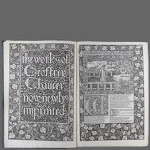
 Painted limestone- Mentuhotep's II temple
Painted limestone- Mentuhotep's II temple
My daughter and I visited the Metropolitan Museum of Art in New York City on Saturday, December 6th, 2008. We had a wonderful day in the city. Our day started with a train ride from New Haven to Grand Central Station and then we took a taxi over to the Met.
The museum was exquisitely decorated for the holidays. The main attraction was a 20 ft. blue spruce tree decorated with antique ornaments located in the Medieval Sculpture Hall. At the base of the tree was a beautifully crafted 18th century Neapolitan nativity scene. It was just breathtaking! There was also a special holiday/religious themed exhibit entitled “Choirs of Angels: Paintings in Italian Choir Books, 1300-1500.”
(www.metmuseum.org/special/se_event.asp?)
There are numerous permanent collections, departments, and temporary exhibitions at the museum. One of my favorite parts of the museum was the section devoted to Egyptian Art. It is truly amazing: it houses over 36,000 objects dating from ca. 300,000 B.C. to the 4th century A.D. The collection was established in the early 1900’s, in which most of the artifacts came from several archeological digs undertaken by the museum. My favorite piece was a block of painted limestone from the sanctuary in the temple of the pharaoh Mentuhotep II from around 2000 B.C. I think it is so amazing how these people were able to erect such monolithic structures and paint such detailed paintings on the walls of their pharaoh’s tombs and temples before the advent of technology. One gets a sense of what daily life was like for both peasants and royalty in Egypt during this time period.
(www.metmuseum.org/works_of_Art/egyptian_art)
I also enjoyed the museums collection of European paintings, which ranges from the 14th to the late 19th centuries. One of my favorite paintings entitled “Young Woman with a Water Pitcher,” was created by the famous Dutch painter and inventor Johannes Vermeer (www.wikipedia.org/wiki/Johannes_Vermeer). It depicts a young woman, washing a window while sunlight pours in through it. I was drawn to this painting because of its simplicity, as well as the fact that it depicts an event from an ordinary person’s life, not from a rich or powerful king, queen, or clergy member. Sometimes it is easy to forget when looking at paintings and portraits, especially those from European artists, just how important servants and trades people were to the upper classes and royal families.
The museum was exquisitely decorated for the holidays. The main attraction was a 20 ft. blue spruce tree decorated with antique ornaments located in the Medieval Sculpture Hall. At the base of the tree was a beautifully crafted 18th century Neapolitan nativity scene. It was just breathtaking! There was also a special holiday/religious themed exhibit entitled “Choirs of Angels: Paintings in Italian Choir Books, 1300-1500.”
(www.metmuseum.org/special/se_event.asp?)
There are numerous permanent collections, departments, and temporary exhibitions at the museum. One of my favorite parts of the museum was the section devoted to Egyptian Art. It is truly amazing: it houses over 36,000 objects dating from ca. 300,000 B.C. to the 4th century A.D. The collection was established in the early 1900’s, in which most of the artifacts came from several archeological digs undertaken by the museum. My favorite piece was a block of painted limestone from the sanctuary in the temple of the pharaoh Mentuhotep II from around 2000 B.C. I think it is so amazing how these people were able to erect such monolithic structures and paint such detailed paintings on the walls of their pharaoh’s tombs and temples before the advent of technology. One gets a sense of what daily life was like for both peasants and royalty in Egypt during this time period.
(www.metmuseum.org/works_of_Art/egyptian_art)
I also enjoyed the museums collection of European paintings, which ranges from the 14th to the late 19th centuries. One of my favorite paintings entitled “Young Woman with a Water Pitcher,” was created by the famous Dutch painter and inventor Johannes Vermeer (www.wikipedia.org/wiki/Johannes_Vermeer). It depicts a young woman, washing a window while sunlight pours in through it. I was drawn to this painting because of its simplicity, as well as the fact that it depicts an event from an ordinary person’s life, not from a rich or powerful king, queen, or clergy member. Sometimes it is easy to forget when looking at paintings and portraits, especially those from European artists, just how important servants and trades people were to the upper classes and royal families.






No comments:
Post a Comment